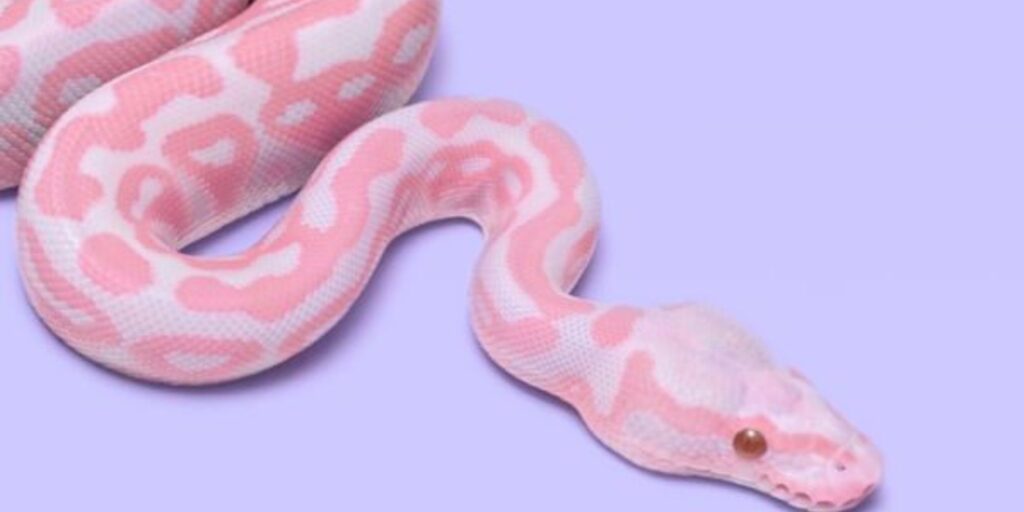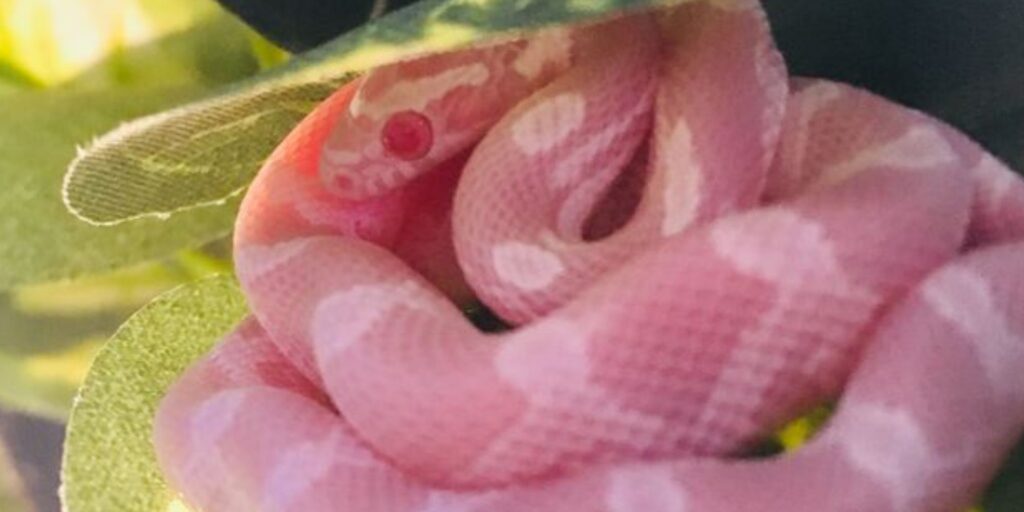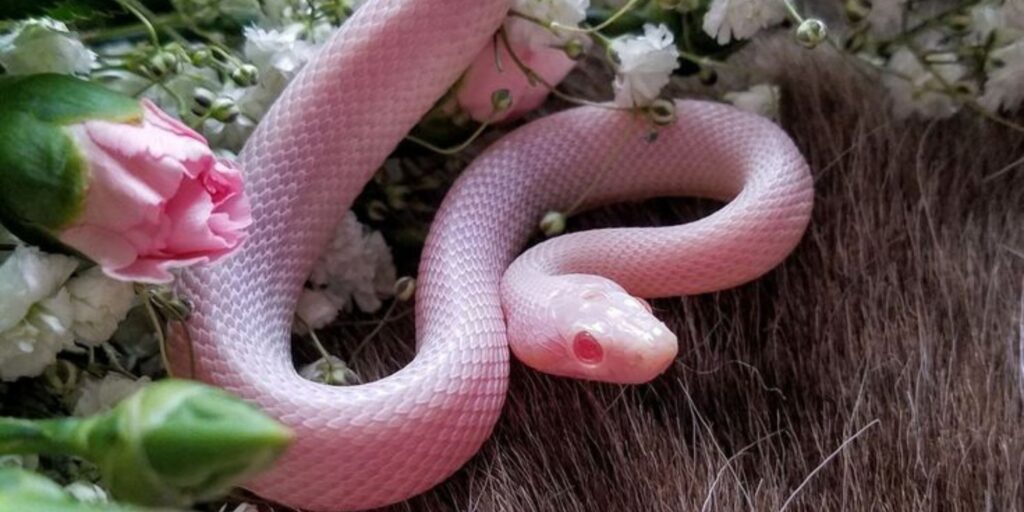Overview
The Pink Snakes is a rare and striking reptile known for its soft pink hue, which varies from pale blush to vibrant shades of pink, depending on the species. These snakes can be found in different parts of the world, though they are not as commonly seen as other more common-colored species. One notable example is the Rosy Boa, native to the southwestern United States, which features a beautiful pink and cream-colored pattern.
A Deep Dive into the Habitat and Behavior of Pink Snakes
Pink snakes, known for their striking coloration, inhabit a variety of environments, depending on the species. One of the most well-known pink snakes is the Rosy Boa, found in the deserts and rocky hills of the southwestern United States. These snakes prefer warm, dry climates and often seek shelter in crevices or burrows to stay cool during the hottest parts of the day. Their soft pink hues provide excellent camouflage in these arid habitats, helping them avoid predators.
Introduction

Pink snakes are captivating creatures that have recently caught the attention of reptile enthusiasts and casual observers alike. With their striking coloration and unique characteristics, they evoke a sense of wonder in anyone who encounters them. These serpents are not just another addition to the world of reptiles; they symbolize beauty, rarity, and intrigue.
But what do we know about pink snakes? Where do they live, how do they behave, and can they thrive as pets? As we embark on this journey through their habitat and behavior, you’ll discover the fascinating nuances that make pink snakes so special. Whether you’re considering adding one to your collection or simply want to learn more about these vibrant reptiles, you’re in for an enlightening experience!
The Habitat of Pink Snakes
Pink snakes are fascinating creatures that thrive in specific environments. They tend to inhabit tropical and subtropical regions, where temperatures remain consistently warm. These conditions support their biological needs and behaviors.
Typically, pink snakes can be found in forested areas or grasslands. Their vibrant coloration helps them blend seamlessly with the colorful flora around them. This camouflage is essential for both hunting prey and evading predators.
Moisture plays a crucial role in their habitat as well. Pink snakes often prefer environments near water sources like rivers or swamps. The humidity aids in shedding skin and maintaining hydration levels, vital aspects of their survival.
These reptiles also exhibit a preference for dense underbrush or foliage. Such locations provide shelter from harsh weather conditions and cover from potential threats. Here they find comfort during the day while waiting for nightfall when they become active hunters.
While some species may occupy arid areas occasionally, these instances are less common. A dry environment can pose challenges to moisture-dependent creatures like pink snakes, making it difficult for them to regulate body temperature effectively.
Human activity has impacted many natural habitats worldwide, including those of pink snakes. Deforestation and urbanization threaten their living spaces significantly, prompting conservation efforts within various regions.
Protecting these unique ecosystems ensures not just the survival of pink snakes but also promotes biodiversity overall—an important consideration as we continue our journey towards ecological sustainability.
The behavior of Pink Snake

Pink snakes exhibit a range of fascinating behaviors that reflect their adaptability and unique nature. These reptiles are primarily nocturnal, meaning they are most active during the night. This trait helps them avoid daytime predators and harsh sunlight, allowing them to hunt effectively under the cover of darkness.
When it comes to hunting, pink snakes rely heavily on their keen sense of smell rather than eyesight. They can detect prey from significant distances using their forked tongues, which pick up scent particles in the air. Once they’ve located potential food sources—usually small mammals or insects—they employ a stealthy approach before striking with precision.
Social interactions among pink snakes are limited but interesting. They tend to be solitary creatures outside of mating season. During this time, males may engage in competitive displays to attract females, showcasing their strength through intricate movements and sometimes wrestling matches with rivals.
Defensive behavior is another intriguing aspect of pink snake life. When threatened, these snakes often resort to camouflaging themselves within their surroundings—blending seamlessly into foliage or debris on the ground. If cornered or attacked, some species might choose to play dead as a last-ditch effort for survival.
Communication in pink snakes is subtle yet vital for interaction between individuals during mating periods. They produce specific body postures and scents that convey readiness for reproduction or territorial boundaries without engaging directly with other snakes unnecessarily.
Pink Snakes as Pets
Pink snakes have captured the hearts of many reptile enthusiasts, making them a popular choice for pet owners. Their stunning coloration and unique appearance draw attention wherever they go. If you’re considering adding a pink snake to your family, there are several factors to keep in mind.
First and foremost is their habitat needs. Pink snakes require an environment that mimics their natural surroundings. This means providing appropriate temperature gradients and humidity levels in their enclosure. A well-maintained terrarium can make all the difference in keeping these reptiles healthy.
Feeding habits also play a significant role in caring for pink snakes. They typically eat small rodents or appropriately-sized prey items, depending on their age and size. It’s essential to provide a balanced diet that meets their nutritional requirements while ensuring fresh water is always available.
Handling can be another aspect worth noting when it comes to pink snakes as pets. These creatures vary in temperament; some may be more docile than others. Regular handling from an early age helps ensure they become accustomed to human interaction, making them easier to manage as adults.
Keep in mind that proper hygiene is critical when owning any pet snake, including pink varieties. Regular cleaning of the enclosure prevents odor buildup and maintains overall health by minimizing parasites or bacteria exposure.
Another consideration is longevity; many species of pink snakes can live over 20 years with proper care! Owning one requires a commitment beyond just initial excitement about having such an exotic pet at home.
It’s wise to research local laws regarding ownership regulations before acquiring a pink snake as a pet since some states or countries might have restrictions on certain species due to conservation efforts or safety concerns related specifically to non-native animals within certain ecosystems.
The Demand for Pink Snake

The allure of pink snakes has surged in recent years, captivating both seasoned snake enthusiasts and newcomers. Their striking appearance makes them a popular choice for reptile collectors. The unique pink coloration often creates a sense of rarity, driving demand further.
As more people discover the charm of pink snakes, breeders are stepping up to meet this increasing interest. This rise in breeding efforts has led to various morphs and patterns being developed within the species. Each new variation adds to their appeal and offers potential owners options that suit personal aesthetic preferences.
Social media platforms have played a significant role in promoting these beautiful creatures. Enthusiasts share stunning photographs and videos showcasing their pets, which helps spark curiosity among those who may not have considered owning a snake before. Online communities dedicated to reptiles offer valuable resources, making it easier for potential pet owners to learn about care requirements specific to pink snakes.
However, with increased popularity comes responsibility. Prospective buyers must research reputable breeders who prioritize ethical practices over profit margins. Ensuring that your future pet is raised in humane conditions is essential for its health and well-being.
Alongside ethical considerations, financial aspects also come into play when discussing the demand for pink snakes. Prices can vary based on factors such as morph type and lineage quality; understanding market trends is important if you’re looking at acquiring one as a pet or investment.
With all this excitement surrounding them, it’s clear why so many people are drawn to these fascinating reptiles!



